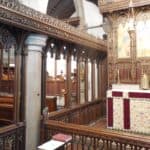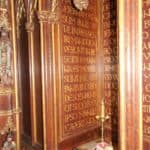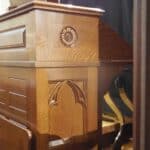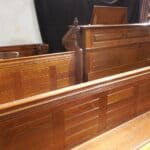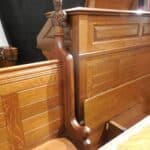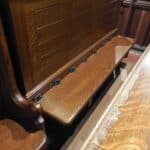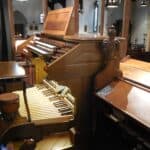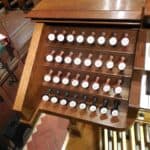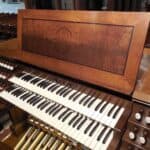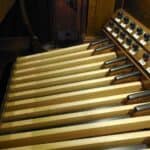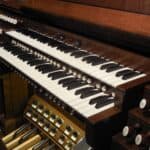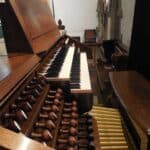Peter Stoltzfus Berton, Director of Music at the historic Zabriskie Memorial Church of St. John the Evangelist (Episcopal) in Newport, Rhode Island, first contacted me in January 2019. Peter had been given my name by Dick Houghten, and inquired about our availability to design and build a new console for the church. Through numerous emails and conversations, Peter, Dick and I developed a plan of action, and J. Zamberlan & Co. signed a design contract with the church later that same month.
Construction of the console, bench and pedalboard began in earnest in the fall. A custom platform was added to the scope of work as well, since the physical situation at the church precluded installing casters within the console itself. This was our first collaboration with Dick that did not entail restoration or creation of a Skinner-esque console — the horizontal stop terraces are closer to our own preferred style utilizing curved, terraced stopjambs. We were able to keep the console dimensions within the desired limits, while still adhering to AGO standards.
As is our practice, each terrace hinges up individually, as do the keyboards, for ease of maintenance. We provided a storage drawer between the drop sills in what would otherwise be wasted space; Dick had reused such a drawer on the Trinity Copley Square project we had done with him a few years prior. The church requested that the lower back panel of the console match, as closely as possible, the pew backs in the choir area; I feel the results speak for themselves. The console shell incorporates several Gothic carvings, which were provided by outside craftsmen. We also provided a hinged bench and folding supports, attached to the console base frame and platform respectively, for up to several choristers; this bench will be professionally carved in the future, in the style of medieval misericords.
The console shell and other furniture were built — as is often the case — of quartersawn white oak; the interior of the console is of walnut. All were stained and finished according to samples we had developed based on a small section of pew loaned to us. We provided a typical veneered music rack, but also made an even shorter one of tempered glass; the two interchange easily, with dowels and rare-earth magnets to aid alignment and keep things in place. Since the bench sits so close to the wall, the height scale is located at one end and is simply read directly against the top of the apron, rather than with a “pointer” moving in a slot. Peter expressed a desire early on for something other than normal plastic sharps for the pedalboard, so we made them of Gabon ebony-capped bocote; we were all quite pleased with the results.
